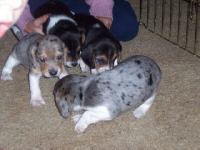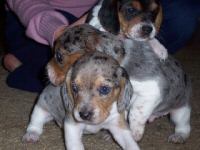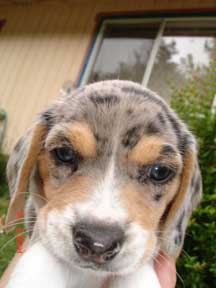NORWEGIAN BLUE BEAGLES--A NEW COLOR--NOT!!!!!!
Beagles come in many different hound colors. The typical
hound colors are of the colors of the Foxhound colors. In the
last 12-24 months, I have received pictures from owners and prospective owners of a new color of beagles
that has never been known to exist. This new color is being
termed "Norwegian blue" or "Russian blue". Neither of these
colors are a recognized option for a beagle.  They are actually an incorrect description of what
appears to be a dapple colored Beagle. The dapple gene or "merle"
gene has never been known or documented to exist in the Beagle color
genetic pattern. All of the genetic references do not list this
color pattern as being one identified in the Beagle breed. This
color pattern seems to be mostly located in northern and southern
California. Numerous reports have come from the San Francisco Bay
area.
They are actually an incorrect description of what
appears to be a dapple colored Beagle. The dapple gene or "merle"
gene has never been known or documented to exist in the Beagle color
genetic pattern. All of the genetic references do not list this
color pattern as being one identified in the Beagle breed. This
color pattern seems to be mostly located in northern and southern
California. Numerous reports have come from the San Francisco Bay
area.
The "blue" color pattern does exist in beagles. But is
actually a recessive gene being expressed as they dilution of the black
gene. Blue beagles will have lighter colored eyes, a dark slate colored nose and a lighter
color to their tan markings. The pictures I have been sent of
these blue beagles show, a beagle with dark eyes, black noses and dark pigment. The reports I have received state that these
beagles are being registered as blue, tan and white. This is an
incorrect color registration as they are not blues, but actually
merles. The ads and report from owners have stated that these
beagles are AKC registered. When I asked for specific pedigree
information and AKC numbers to initiate a genetic study of their
backgrounds; I have not received valid AKC information that could be
verified by AKC.
pigment. The reports I have received state that these
beagles are being registered as blue, tan and white. This is an
incorrect color registration as they are not blues, but actually
merles. The ads and report from owners have stated that these
beagles are AKC registered. When I asked for specific pedigree
information and AKC numbers to initiate a genetic study of their
backgrounds; I have not received valid AKC information that could be
verified by AKC.
One owner, specifically said that these beagles were rare, and from
Norway. This owner implied that unless I was familiar with the
Norwegian beagles; I would not have adequate information
concerning this new color. I did contact breeders internationally
as well as judges that Judge in Europe. None had ever seen or
ever heard of a Norwegian blue. That includes a Norwegian breeder
of over 20 years experience. Her comment upon seeing pictures of
this color of beagle was that it had to be a mixed breed and that
pattern did not exist in Norway. There is a totally separate
breed that is recognized in Norway that is named, the Norwegian Dunker
that does have a dapple marking. This breed is very rare and is
thought to have been developed by crossing with another breed. This
is a separate breed, not a beagle and is not recognized by AKC.
I would like to acquire specific information and registration
information concerning one of these new color of beagles that could be
verified with AKC. Until this information is available, it
is a assumed that these beagles do have some other breed in them,
possibly two to three generations back that introduced this new color
pattern. It could have been totally accidental, or it could been
done on purpose, that is the unknown factor. The bottom line is
that you should not spend large amounts of money for this new rare
color beagle as it is probably actually a mix breed. Many ads
have stated that they are AKC registered, but some prospective owners
were not given actual litter registration papers but were told that the
papers were on their way to or from AKC. Names of sire and dam
and registration numbers were obtained, but AKC did not have any litter
registration being processed for those animals. If anyone reading
this does have an AKC registered Beagle that has this color pattern, I
would love to get a copy of the AKC registration papers. I am
open to finding out that this color has "appeared" in AKC beagles and
maybe is a fluke mutation or is some long lost color pattern that did
exist many many generations ago. But since the "merle" gene is
dominant it does not seem likely it has remained hidden for so long.
One concern about this new merle pattern existing in beagles is that it
is a dominant pattern, which means one of the parents has to have a
merle pattern. You cannot breed two tri color beagles and get
a dapple. When you have a doubling of this merle gene there
are a number of significant health problems associated with it.
Specifically, deafness, blindness and death. So breeding two merle's can actually
express major health problems.
For more information on acceptable colors in beagles, please visit the
National Beagle Club web site.
 They are actually an incorrect description of what
appears to be a dapple colored Beagle. The dapple gene or "merle"
gene has never been known or documented to exist in the Beagle color
genetic pattern. All of the genetic references do not list this
color pattern as being one identified in the Beagle breed. This
color pattern seems to be mostly located in northern and southern
California. Numerous reports have come from the San Francisco Bay
area.
They are actually an incorrect description of what
appears to be a dapple colored Beagle. The dapple gene or "merle"
gene has never been known or documented to exist in the Beagle color
genetic pattern. All of the genetic references do not list this
color pattern as being one identified in the Beagle breed. This
color pattern seems to be mostly located in northern and southern
California. Numerous reports have come from the San Francisco Bay
area. pigment. The reports I have received state that these
beagles are being registered as blue, tan and white. This is an
incorrect color registration as they are not blues, but actually
merles. The ads and report from owners have stated that these
beagles are AKC registered. When I asked for specific pedigree
information and AKC numbers to initiate a genetic study of their
backgrounds; I have not received valid AKC information that could be
verified by AKC.
pigment. The reports I have received state that these
beagles are being registered as blue, tan and white. This is an
incorrect color registration as they are not blues, but actually
merles. The ads and report from owners have stated that these
beagles are AKC registered. When I asked for specific pedigree
information and AKC numbers to initiate a genetic study of their
backgrounds; I have not received valid AKC information that could be
verified by AKC.
